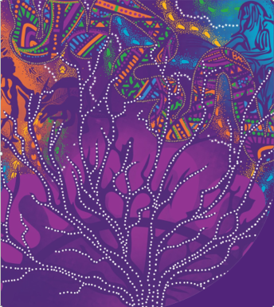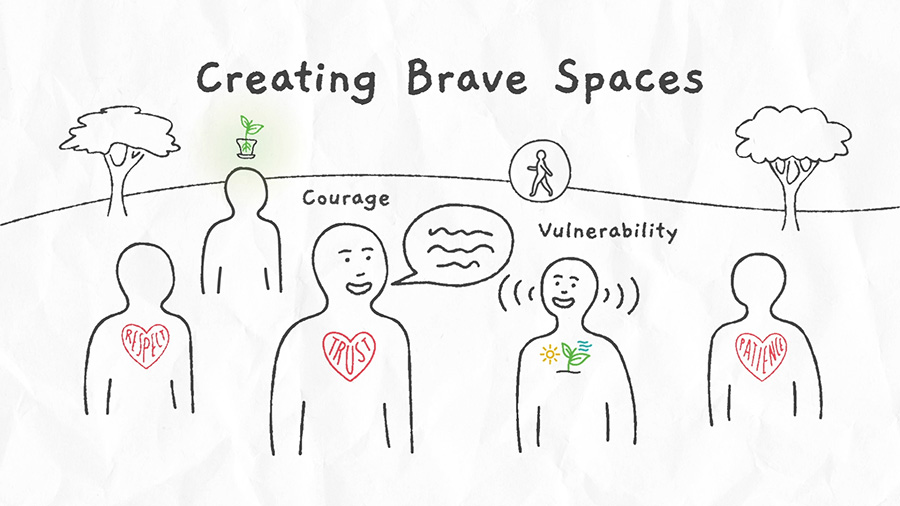Welcome to the Creating Brave Spaces for Health Communication module.
Acknowledgement of Country
 We would like to acknowledge the Traditional Custodians of the lands on which this module was designed and developed, the Yuggera and Turrbal people. We invite you to learn about and acknowledge the Traditional Custodians of the lands on which you join us.
We would like to acknowledge the Traditional Custodians of the lands on which this module was designed and developed, the Yuggera and Turrbal people. We invite you to learn about and acknowledge the Traditional Custodians of the lands on which you join us.
We would like to pay our respects to the Ancestors and Descendants of these lands and acknowledge their continued cultural and spiritual connections to Country. We would also like to recognise their valuable contributions to Australian and global society.
Acknowledging Country is not a tick box exercise, particularly in this module about creating brave and safer spaces in health communication. Acknowledging Country is a process for learning and respectfully engaging in cultural protocols from your own cultural position. By situating ourselves in relationship to Country, we are seeking to be open and to reflect on the space and place we occupy – working to make it more culturally respectful and inclusive. With that in mind, we would like to acknowledge the tremendous contribution of Aboriginal and Torres Strait Islander peoples to Western ideas and understanding of the concepts and practices that we will be learning about in this module.
Learning Objectives
 With these important introductory notes, let’s dive into the Learning Objectives for this module:
With these important introductory notes, let’s dive into the Learning Objectives for this module:
By the end of this module, you will be able to:
- Understand the concepts ‘identity’ and ‘culture’
- Identify and understand how identity and culture inform the differences between cultural competence, cultural safety and cultural humility in health communication
- Identify the role of reflection and reflexivity in creating brave and safer spaces for health communication 1,2
- Understand the importance of creating brave and safer spaces for health communication1,2
Disclaimer: Sometimes learning is a bit uncomfortable. You may be aware of these feelings during some parts of this module. We encourage you to notice when this is happening and spend time to reflect on why these feelings of discomfort might have arisen to deepen your learning experience.
As you go through this module, we suggest that you1:
- Understand that you may not agree with everything about this aspect of health communication
- Own your own intentions and impact in health communication
- Enter into health communication challenges by choice and with intention
- Consider what respect looks like for you as you engage with this module and as you seek to apply this to health communication contexts
- Remember to challenge ideas and not people.
4. What is a brave and safer space? Why do we need them in health communication?
In this module, we are asking you to consider how discomfort or vulnerability may be opportunities for us to break biased patterns of thinking, advocate in solidarity, and/or be open to learning something new.
There are many power imbalances to consider in health and health communication. For example, between practitioners and patients, researchers and participants, or lecturers and students.
When we are challenged to address power imbalances that are intrinsic in our relationship dynamics and communities, it pushes against the status quo of the hierarchical cultures and institutions that we live and work within. This requires us to be vulnerable and brave.
We can approach this work by creating what are referred to as ‘safe’, ‘brave’, or perhaps ‘safer’ spaces1,2.
First, let’s take a closer look at how safe spaces and brave spaces differ and why that distinction matters.
As Jama Shelton presents in the video above, emotional safety is useful and important in certain settings, but it is arguably impossible to eliminate risk entirely, as the idea of a ‘safe space’ implies.
A brave and/or safer space takes this nuance into consideration, differentiating between safety and discomfort while also prioritising the physical and emotional safety of people from less-dominant groups (i.e. people with identities that are marginalised or not represented by generalised social ‘norms’)1,2.
Jama Shelton also notes that people from less-dominant groups are navigating and negotiating safety and bravery on a regular basis. Brave and/or safer spaces are not about creating a space for everyone to feel comfortable, but rather to create spaces for communities or people with less structural or societal power to feel able to share and be heard. For those in more-dominant groups, this could cause discomfort and difficulty, which (as we explored in the animation) may be useful and necessary opportunities for growth and learning2.
These positions might be something that you identify with and experience, or they could be something new for you to consider.

As we begin to think about the process of creating and engaging in brave and safer spaces in health communication, it is vital to acknowledge the diverse lived experiences of the people participating in these spaces to ensure respect, inclusivity, and authenticity are maintained.
In practice, brave and safer spaces in health communication offer opportunities for students and professionals to engage in difficult dialogue around health justice and systemic challenges, galvanising ourselves and our peers to do the work required to make changes that move us toward a more equitable world.
Let’s explore how to navigate these complexities in a way that is constructive and supportive of growth and learning in health communication practice.
